A Method of Reducing Invalid Steering for AUVs Based on a Wave Peak Frequency Tracker
Abstract
1. Introduction
2. System Description and Identification Model
3. Design of the Wave Peak Frequency Tracker
3.1. The RELS Algorithm
- (1)
- Let , , , , and for , and is taken to be a large number, e.g., .
- (2)
- (3)
- (4)
- Update the parameter estimate by using (24).
- (5)
- Compute by using (30).
- (6)
- Increase t by 1 and go to Step 2.
3.2. Wave Peak Frequency Calculation
4. The Heading Control System of an AUV with a Wave Peak Frequency Tracker
4.1. Nomoto Model
4.2. Back-Stepping Controller Design
4.3. Observer Design
5. Simulation Results and Analysis
6. Conclusions
Author Contributions
Funding
Institutional Review Board Statement
Data Availability Statement
Conflicts of Interest
References
- Khodayari, M.H.; Balochian, S. Modeling and control of autonomous underwater vehicle (AUV) in heading and depth attitude via self-adaptive fuzzy PID controller. J. Mar. Sci. Technol. 2015, 20, 559–578. [Google Scholar] [CrossRef]
- Garcia-Garcia, D.; Valeriano-Medina, Y.; Hernández, L.; Martínez, A.; Martínez-Espinosa, Y. Wave disturbance compensation for AUV diving control in shallow water environment. J. Appl. Res. Technol. 2019, 17, 326–337. [Google Scholar]
- Dantas, J.L.D.; de Barros, E.A.; da Cruz, J.J. AUV control in the diving plane subject to waves. IFAC Proc. Vol. 2012, 45, 319–324. [Google Scholar] [CrossRef]
- Fossen, T.I. Guidance and Control of Ocean Vehicles; Wiley: New York, NY, USA, 1994. [Google Scholar]
- Fossen, T.I. Handbook of Marine Craft Hydrodynamics and Motion Control; John Wiley & Sons: Noida, India, 2011. [Google Scholar]
- Sakai, M.; Umeda, N.; Maki, A. Encounter frequency effect on the simplified design criteria against parametric roll. Ocean Eng. 2019, 182, 21–27. [Google Scholar] [CrossRef]
- Værnø, S.A.; Skjetne, R.; Kjerstad, ø.K.; Calabrò, V. Comparison of control design models and observers for dynamic positioning of surface vessels. Control Eng. Pract. 2019, 85, 235–245. [Google Scholar] [CrossRef]
- Zhang, X.; Han, X.; Guan, W.; Zhang, G. Improvement of integrator backstepping control for ships with concise robust control and nonlinear decoration. Ocean Eng. 2019, 189, 106349. [Google Scholar] [CrossRef]
- Guan, W.; Cao, W.; Sun, J.; Su, Z. Steering controller design for smart autonomous surface vessel based on CSF L2 gain robust strategy. IEEE Access 2019, 7, 109982–109989. [Google Scholar] [CrossRef]
- Ding, F. System Identification—New Theory and Methods; Science: Beijing, China, 2013. [Google Scholar]
- Xu, L. Parameter estimation algorithms for dynamical response signals based on the multi-innovation theory and the hierarchical principle. IET Signal Process. 2017, 11, 228–237. [Google Scholar] [CrossRef]
- Ma, F.; Yin, Y.; Li, M. Start-up process modelling of sediment microbial fuel cells based on data driven. Math. Probl. Eng. 2019, 2019, 7403732. [Google Scholar] [CrossRef]
- Van Wingerden, J.; Verhaegen, M. Subspace identification of bilinear and LPV systems for open-and closed-loop data. Automatica 2009, 45, 372–381. [Google Scholar] [CrossRef]
- Sun, Z.; Zhang, D.; Meng, Q.; Chen, C. Feedback stabilisation of time-delay nonlinear systems with continuous time-varying output function. Int. J. Syst. Sci. 2019, 50, 244–255. [Google Scholar] [CrossRef]
- Li, M.; Liu, X. The filtering-based maximum likelihood iterative estimation algorithms for a special class of nonlinear systems with autoregressive moving average noise using the hierarchical identification principle. Int. J. Adapt. Control Signal Process. 2019, 33, 1189–1211. [Google Scholar] [CrossRef]
- Wang, Y.; Ding, F.; Wu, M. Recursive parameter estimation algorithm for multivariate output-error systems. J. Frankl. Inst. 2018, 355, 5163–5181. [Google Scholar] [CrossRef]
- Wang, D. Input–output data filtering based recursive least squares identification for CARARMA systems. Digit. Signal Process. 2010, 20, 991–999. [Google Scholar] [CrossRef]
- Xiao, Y.; Yue, N. Parameter estimation for nonlinear dynamical adjustment models. Math. Comput. Model. 2011, 54, 1561–1568. [Google Scholar] [CrossRef]
- Ding, F.; Liu, X.; Chu, J. Gradient-based and least-squares-based iterative algorithms for Hammerstein systems using the hierarchical identification principle. IET Control Theory Appl. 2013, 7, 176–184. [Google Scholar] [CrossRef]
- Ding, F.; Liu, P.X.; Liu, G. Gradient based and least-squares based iterative identification methods for OE and OEMA systems. Digit. Signal Process. 2010, 20, 664–677. [Google Scholar] [CrossRef]
- Ding, F. Two-stage least squares based iterative estimation algorithm for CARARMA system modeling. Appl. Math. Model. 2013, 37, 4798–4808. [Google Scholar] [CrossRef]
- Ding, F. Decomposition based fast least squares algorithm for output error systems. Signal Process. 2013, 93, 1235–1242. [Google Scholar] [CrossRef]
- Ding, F.; Chen, H.; Xu, L.; Dai, J.; Li, Q.; Hayat, T. A hierarchical least squares identification algorithm for Hammerstein nonlinear systems using the key term separation. J. Frankl. Inst. 2018, 355, 3737–3752. [Google Scholar] [CrossRef]
- Ji, Y.; Jiang, X.; Wan, L. Hierarchical least squares parameter estimation algorithm for two-input Hammerstein finite impulse response systems. J. Frankl. Inst. 2020, 357, 5019–5032. [Google Scholar] [CrossRef]
- Xu, L.; Xiong, W.; Alsaedi, A.; Hayat, T. Hierarchical parameter estimation for the frequency response based on the dynamical window data. Int. J. Control Autom. Syst. 2018, 16, 1756–1764. [Google Scholar] [CrossRef]
- Wang, D.; Zhang, W. Improved least squares identification algorithm for multivariable Hammerstein systems. J. Frankl. Inst. 2015, 352, 5292–5307. [Google Scholar] [CrossRef]
- Chen, H.; Ding, F.; Xiao, Y. Decomposition-based least squares parameter estimation algorithm for input nonlinear systems using the key term separation technique. Nonlinear Dyn. 2015, 79, 2027–2035. [Google Scholar] [CrossRef]
- Ji, Y.; Kang, Z. Three-stage forgetting factor stochastic gradient parameter estimation methods for a class of nonlinear systems. Int. J. Robust Nonlinear Control 2021, 31, 971–987. [Google Scholar] [CrossRef]
- Xu, L. The damping iterative parameter identification method for dynamical systems based on the sine signal measurement. Signal Process. 2016, 120, 660–667. [Google Scholar] [CrossRef]
- Xu, L. Separable multi-innovation stochastic gradient estimation algorithm for the nonlinear dynamic responses of systems. Int. J. Adapt. Control Signal. 2020, 34, 937–954. [Google Scholar] [CrossRef]
- Wang, L.; He, Y. Recursive least squares parameter estimation algorithms for a class of nonlinear stochastic systems with colored noise based on the auxiliary model and data filtering. IEEE Access 2019, 7, 181295–181304. [Google Scholar] [CrossRef]
- Guo, C.; Wang, L.; Deng, F. The auxiliary model based hierarchical estimation algorithms for bilinear stochastic systems with colored noises. Int. J. Control Autom. Syst. 2020, 18, 650–660. [Google Scholar] [CrossRef]
- Wang, C.; Tang, T. Recursive least squares estimation algorithm applied to a class of linear-in-parameters output error moving average systems. Appl. Math. Lett. 2014, 29, 36–41. [Google Scholar] [CrossRef]
- Du, J.; Hu, X.; Krstić, M.; Sun, Y. Dynamic positioning of ships with unknown parameters and disturbances. Control Eng. Pract. 2018, 76, 22–30. [Google Scholar] [CrossRef]
- Deng, F.; Wang, L.; Jiao, D. Adaptive observer based backstepping controller design for dynamic ship positioning. China Ocean Eng. 2017, 31, 639–645. [Google Scholar] [CrossRef]
- Torsetnes, G.; Jouffroy, J.; Fossen, T.I. Nonlinear dynamic positioning of ships with gain-scheduled wave filtering. In Proceedings of the 2004 43rd IEEE Conference on Decision and Control (CDC) (IEEE Cat. No.04CH37601), Nassau, Bahamas, 14–17 December 2004; pp. 5340–5347. [Google Scholar]
- Wang, X.; Xu, H. Robust autopilot with wave filter for ship steering. J. Mar. Sci. Appl. 2006, 5, 24–29. [Google Scholar]
- Hassani, V.; Pascoal, A.M.; Aguiar, A.P.; Athans, M. A multiple model adaptive wave filter for dynamic ship positioning. IFAC Proc. Vol. 2010, 43, 120–125. [Google Scholar] [CrossRef]
- Lauvdal, T.; Fossen, T.I. Robust adaptive ship autopilot with wave filter and integral action. Int. J. Adapt. Control Signal Process. 1998, 12, 605–622. [Google Scholar] [CrossRef]
- Fossen, T.I. Marine Control Systems: Guidance, Navigation and Control of Ships, Rigs and Underwater Vehicles; Marine Cybernetics: Trondheim, Norway, 2002. [Google Scholar]
- Bryne, T.H.; Fossen, T.I.; Johansen, T.A. Design of inertial navigation systems for marine craft with adaptive wave filtering aided by triple-redundant sensor packages. Int. J. Adapt. Control Signal Process. 2017, 31, 522–544. [Google Scholar] [CrossRef]
- Hassani, V.; Pascoal, A.M.; Sørensen, A.J. A novel methodology for adaptive Wave Filtering of marine vessels: Theory and experiments. In Proceedings of the 52nd IEEE Conference on Decision and Control, Firenze, Italy, 10–13 December 2013; pp. 6162–6167. [Google Scholar]
- Gu, Y.; Zhu, Q.; Nouri, H. Bias compensation-based parameter and state estimation for a class of time-delay non-linear state-space models. IET Control Theory Appl. 2020, 14, 2176–2185. [Google Scholar] [CrossRef]
- Gu, Y.; Zhu, Q.; Li, C.; Zhu, P.; Nouri, H. State filtering and parameter estimation for two-input two-output systems with time delay. IET Control Theory Appl. 2021, 15, 2053–2066. [Google Scholar] [CrossRef]
- Xu, L.; Chen, F. Hierarchical recursive signal modeling for multifrequency signals based on discrete measured data. Int. J. Adapt. Control Signal. 2021, 35, 676–693. [Google Scholar] [CrossRef]
- Ji, Y.; Zhang, C.; Kang, Z.; Yu, T. Parameter estimation for block-oriented nonlinear systems using the key term separation. Int. J. Robust Nonlinear Control 2020, 30, 3727–3752. [Google Scholar] [CrossRef]
- Wang, L.; Ji, Y.; Wan, L.; Bu, N. Hierarchical recursive generalized extended least squares estimation algorithms for a class of nonlinear stochastic systems with colored noise. J. Frankl. Inst. 2019, 356, 10102–10122. [Google Scholar] [CrossRef]
- Wang, L.; Ji, Y.; Yang, H.; Xu, L. Decomposition-based multiinnovation gradient identification algorithms for a special bilinear system based on its input-output representation. Int. J. Robust Nonlinear Control 2020, 30, 3607–3623. [Google Scholar] [CrossRef]
- Xu, L.; Song, G. A recursive parameter estimation algorithm for modeling signals with multi-frequencies. Circuits Syst. Signal Process. 2020, 39, 4198–4224. [Google Scholar] [CrossRef]
- An, L.; Li, Y.; Jiang, Y.; Li, Y.; Cao, J.; He, J. Soft-switching proximate time optimal heading control for underactuated autonomous underwater vehicle. IEEE Access 2019, 7, 143233–143249. [Google Scholar]

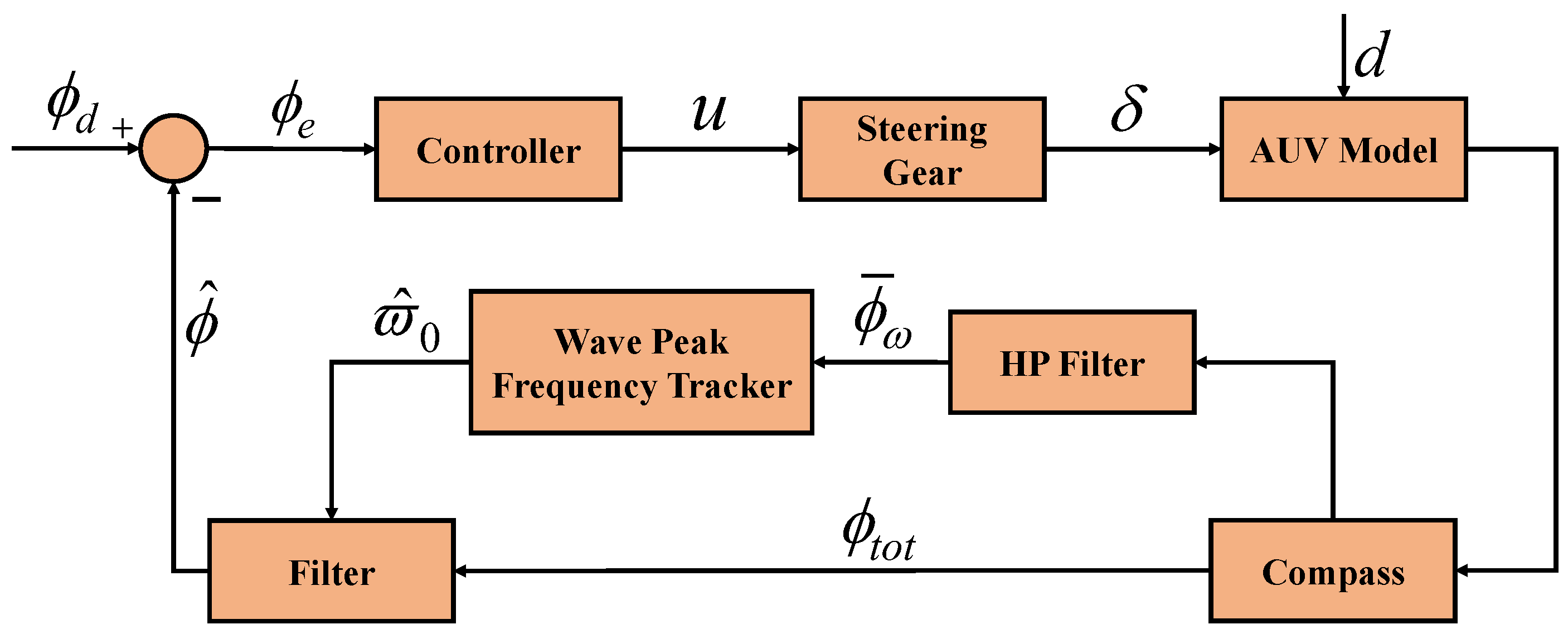
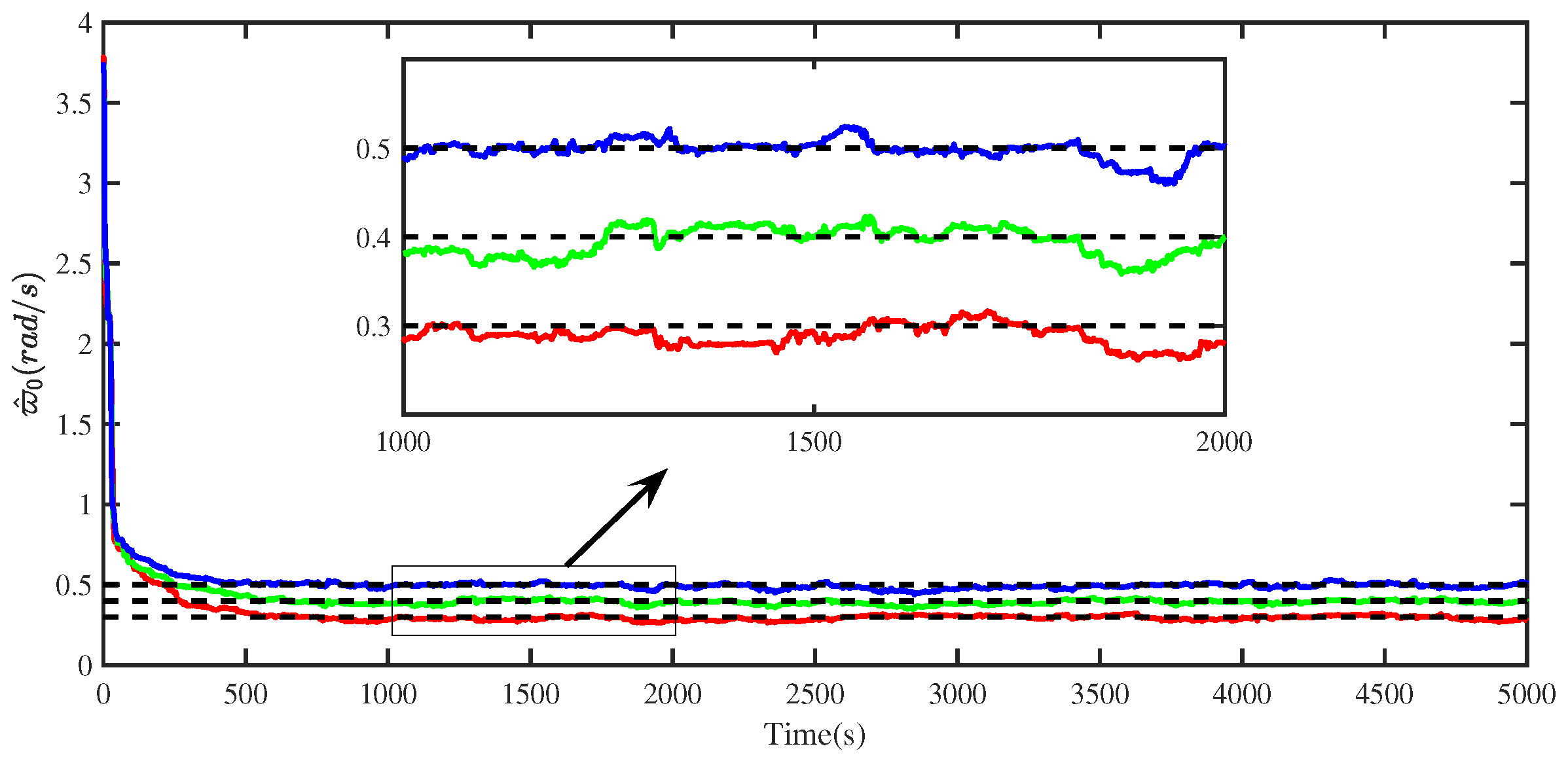
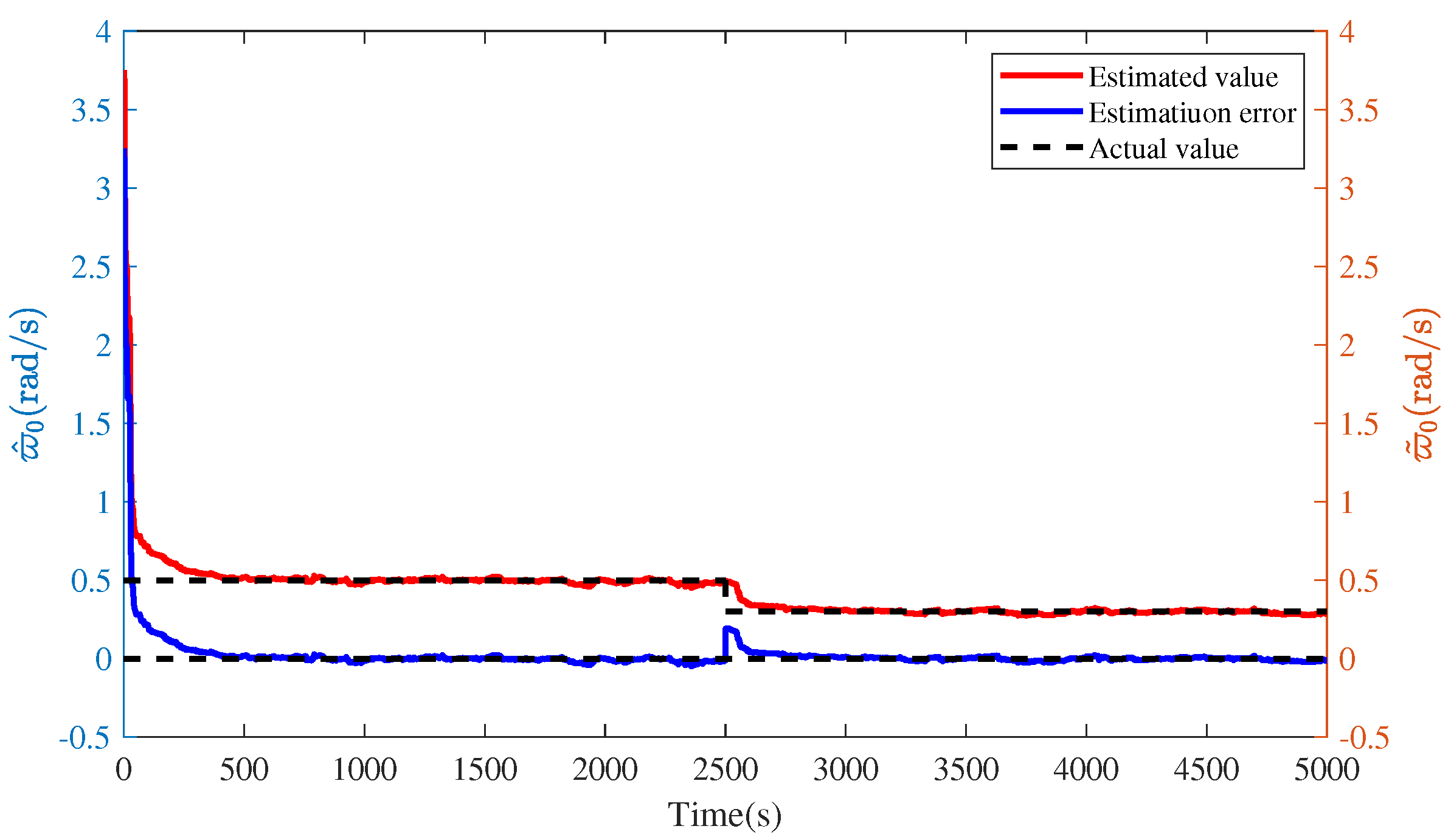

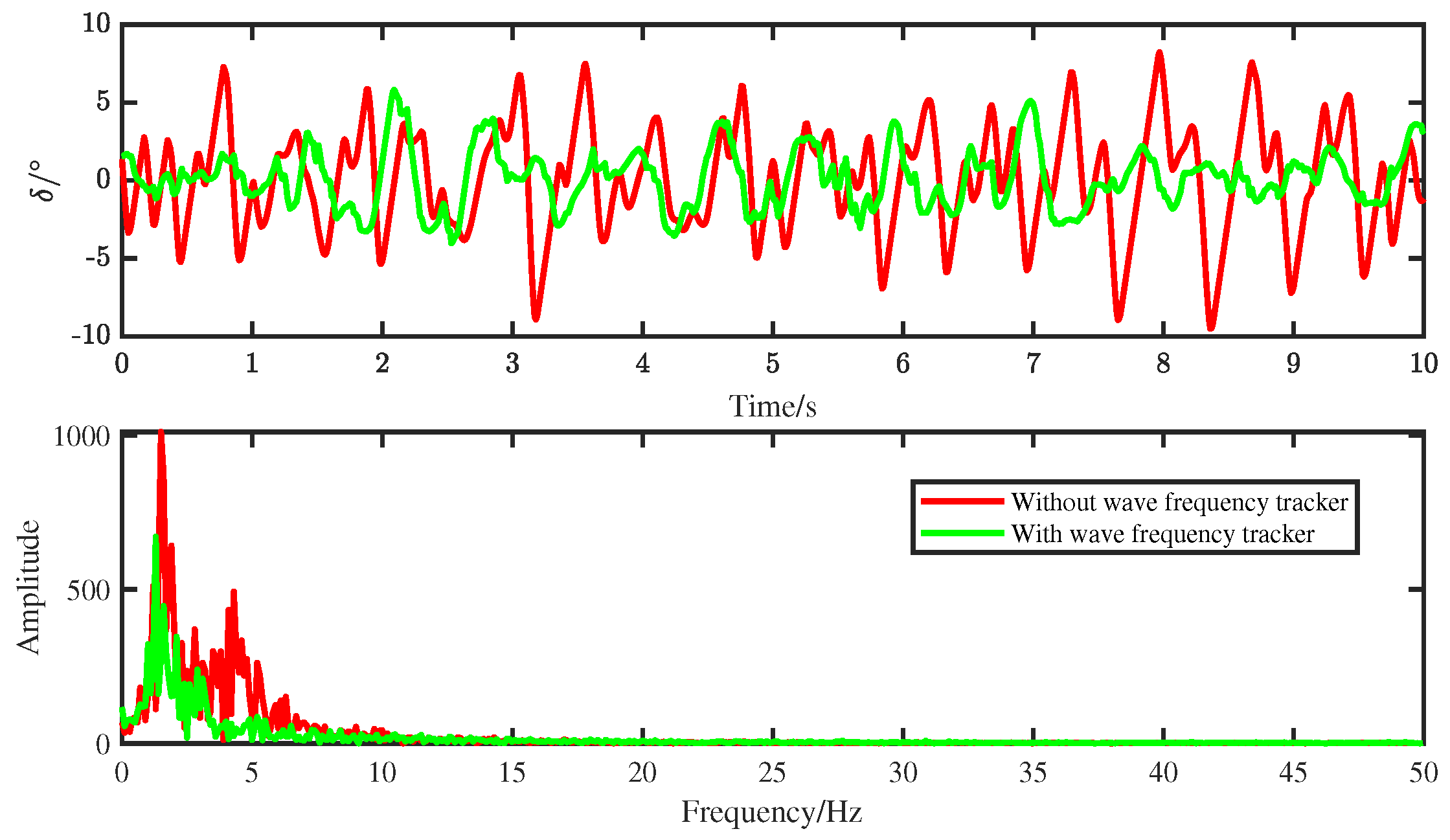
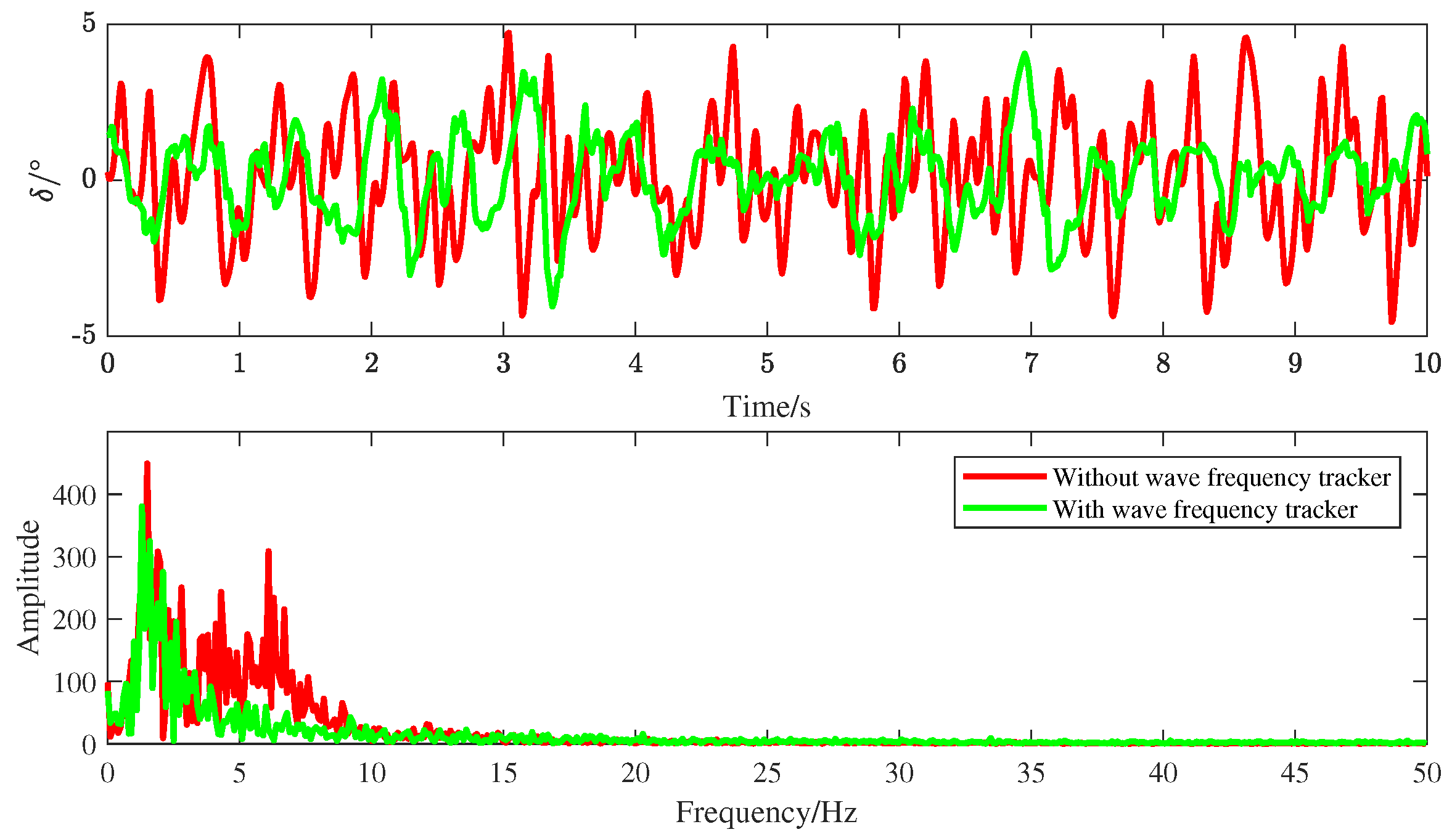
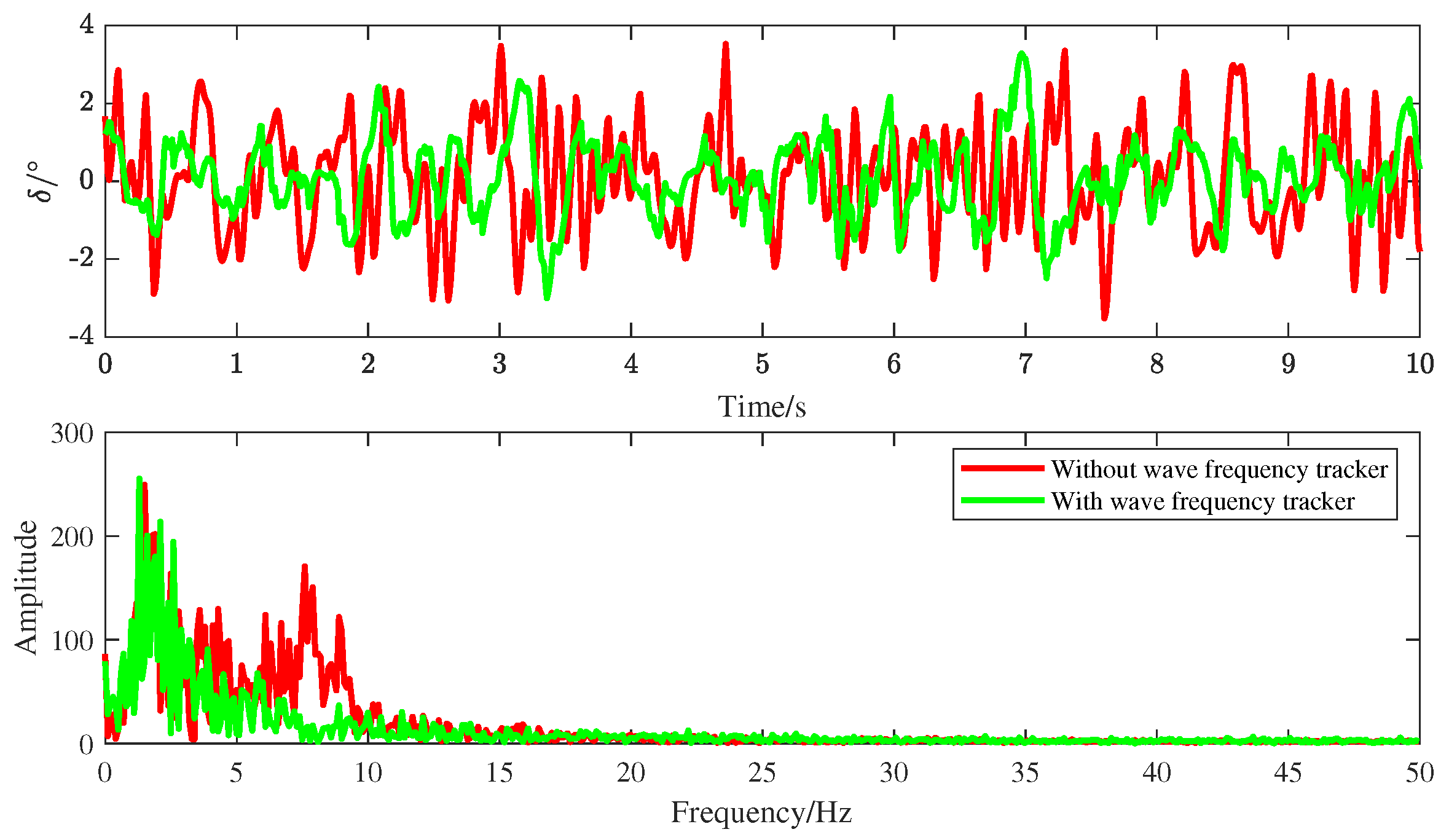
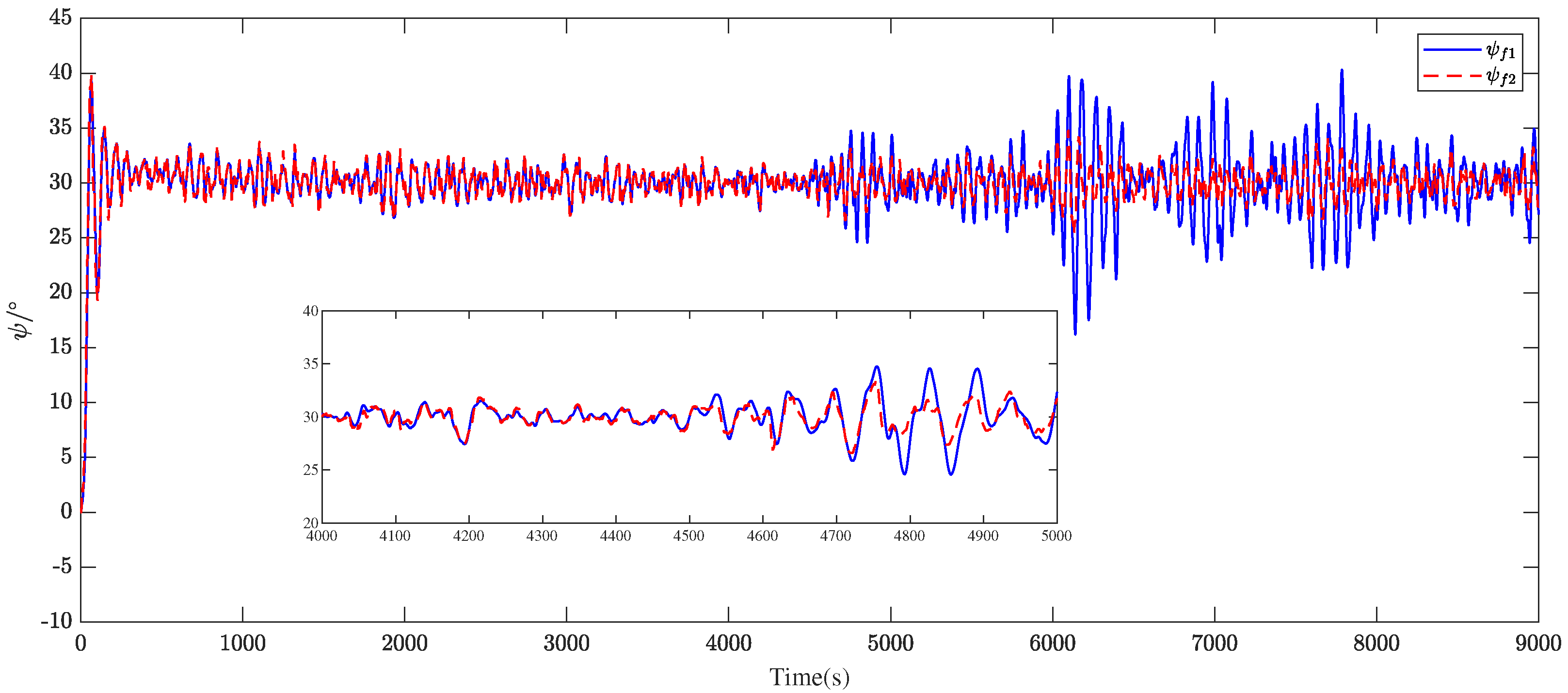
| t | ||
|---|---|---|
| 100 | 0.71362 | 57.27539 |
| 200 | 0.60905 | 78.19031 |
| 500 | 0.51826 | 96.34836 |
| 1000 | 0.48592 | 97.18349 |
| 1500 | 0.50419 | 99.16230 |
| 2500 | 0.49000 | 98.00060 |
| 2600 | 0.35072 | 83.09367 |
| 2700 | 0.33395 | 88.68271 |
| 3000 | 0.31190 | 96.03276 |
| 3500 | 0.30010 | 99.96686 |
| 4000 | 0.30645 | 97.84896 |
| 4500 | 0.30126 | 99.57898 |
| 5000 | 0.28592 | 97.89700 |
Publisher’s Note: MDPI stays neutral with regard to jurisdictional claims in published maps and institutional affiliations. |
© 2022 by the authors. Licensee MDPI, Basel, Switzerland. This article is an open access article distributed under the terms and conditions of the Creative Commons Attribution (CC BY) license (https://creativecommons.org/licenses/by/4.0/).
Share and Cite
Yuan, J.; Li, J.; Dong, Z.; Chen, Q.; Sun, H. A Method of Reducing Invalid Steering for AUVs Based on a Wave Peak Frequency Tracker. Sustainability 2022, 14, 15357. https://doi.org/10.3390/su142215357
Yuan J, Li J, Dong Z, Chen Q, Sun H. A Method of Reducing Invalid Steering for AUVs Based on a Wave Peak Frequency Tracker. Sustainability. 2022; 14(22):15357. https://doi.org/10.3390/su142215357
Chicago/Turabian StyleYuan, Jianping, Jin Li, Zhihui Dong, Qinglong Chen, and Hanbing Sun. 2022. "A Method of Reducing Invalid Steering for AUVs Based on a Wave Peak Frequency Tracker" Sustainability 14, no. 22: 15357. https://doi.org/10.3390/su142215357
APA StyleYuan, J., Li, J., Dong, Z., Chen, Q., & Sun, H. (2022). A Method of Reducing Invalid Steering for AUVs Based on a Wave Peak Frequency Tracker. Sustainability, 14(22), 15357. https://doi.org/10.3390/su142215357







